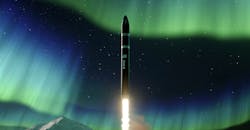Lockheed Missile Interceptor Design is on Target
Lockheed Martin reports it successfully validated designs for all elements of its Next Generation Interceptor (NGI) project with the U.S. Missile Defense Agency, keeping that new defense system on track for deployment later this decade.
The defense manufacturer calls the NGI a “never fail weapon system” designed to increase protection for military and civilian assets against ballistic missile threats. “It has advanced hit-to-kill technology, allowing the interceptor to collide with enemy missiles in body-to-body impact.”
In addition to targeting those threats, the NGI system will identify missile launches, locate targets, calculate routes, and guide the interceptor during its transit to the target. Lockheed calls NGI “the future of the MDA's Ground-Based Missile Defense system” for the U.S. against intercontinental ballistic missile threats.
Lockheed’s first fully operational NGI is scheduled for delivery to U.S. Missile Defense Agency in 2027.
Through a series of preliminary design reviews of all the NGI’s major subsystems, Lockheed states the weapon system demonstrated its “design maturity”, with reduced risk for critical technologies.
"Lockheed Martin is making rapid progress with our NGI solution, remaining on an accelerated schedule toward flight testing," stated Sarah Reeves, vice president of NGI at Lockheed Martin. "During these reviews, we took a modern and transparent approach through the use of advanced digital engineering and model-based engineering tools. Our NGI team will continue on-plan to demonstrate our revolutionary NGI architecture, leveraging mature technologies for high mission confidence."
Northrop Grumman is also developing a missile interceptor, and it recently reported it is working to deliver a first prototype by 2027.
